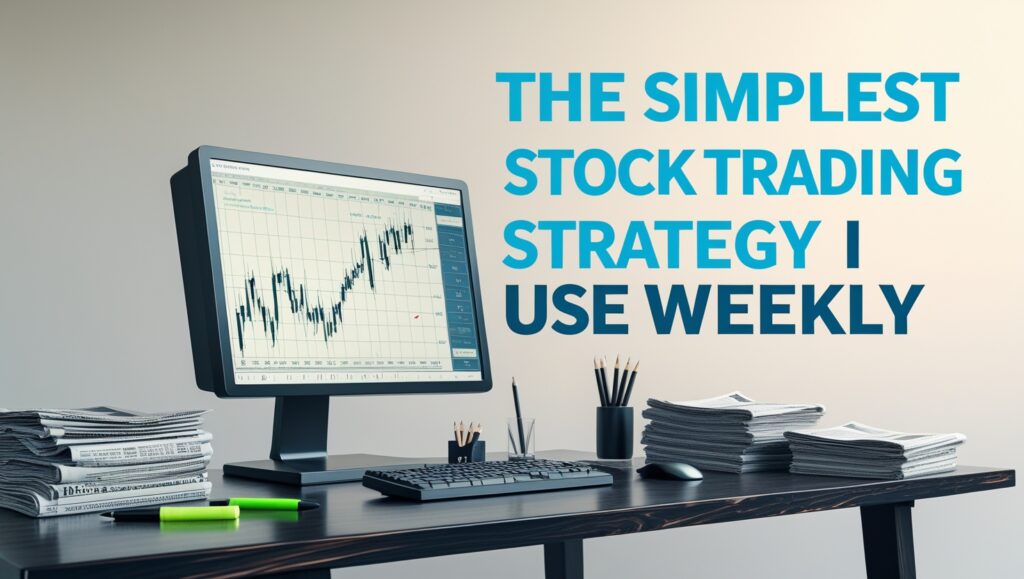The Simplest Stock Trading Strategy I Use Weekly
The Simplest Stock Trading Strategy I Use Weekly
When I first started trading, I thought I needed five monitors, complicated indicators, and access to expensive software just to stand a chance. I was wrong. What actually made me profitable wasn’t more tools — it was simplifying everything.
Over time, I developed one weekly trading strategy that works for me no matter what the market throws. It’s simple, repeatable, and keeps me consistent. And I didn’t need a course to figure it out. I just had to test, fail, and find what clicked.

Table of Contents
Why I Keep It Simple
The market moves fast. If you’re overanalyzing every candle or switching strategies daily, you’re already behind. I realized that I don’t need to catch every move — I just need a setup I can trust and repeat.
I focus on finding momentum early, watching for volume spikes near support zones, and making sure there’s a clean setup with enough range. That’s it. No RSI, no MACD, no over-complication.
My Weekly Setup Routine
Every Sunday, I go through a process that takes about 30 minutes:
- I look for stocks with news catalysts
- I filter for high relative volume and clean daily charts
- I create a watchlist of 6 or fewer stocks
- I define where I want to enter, exit, and cut the trade
That plan gives me clarity going into Monday. No guesswork. I already know what I’m looking for — and I stay away from everything else.
Why It Works for Me
This strategy works because I don’t chase. I let the trade come to me. I know my levels, I know what setups I trust, and I don’t force anything. It took me months of losses to realize that discipline beats excitement.
By simplifying things, I removed stress. I stopped worrying about catching everything. And when I focused on less, I actually made more.
You Don’t Need to Trade Every Day
With this approach, I’m usually in 2–3 trades a week. That’s it. But those setups are clean, planned, and follow my rules. I’d rather wait for a quality trade than gamble on five random ones.
If you’re working a full-time job or have limited time, this strategy fits. You don’t have to be glued to the screen all day. Just follow a plan, focus on key setups, and protect your capital.
Want to See the Full System I Use?
I broke down my exact process — how I build my weekly watchlist, how I spot momentum, and how I stay consistent — in my ebook.
👉 Grab my ebook here – How I Pay My Bills With Simple Stock Setups
Whether you’re brand new or tired of overcomplicating trading, this ebook gives you the clarity I wish I had when I started.
Why I Avoid Indicators Altogether
I used to load my charts with indicators. I’d sit there confused, waiting for five signals to line up. But most of the time, by the time they did, the move was already gone. Now I rely on price action and volume. That’s it. I trust the chart to tell me what I need to know.
My Entry Criteria Is Clear and Repeatable
When I find a stock that’s gapping up with volume, I immediately zoom into the 5-minute chart. I wait for a clean pullback to support — and only enter if it shows strength again. This simple rule alone has saved me from hundreds of bad entries.
I Only Trade Names I Understand
Every week, I avoid penny stocks or random tickers I’ve never seen. Instead, I focus on repeat movers — stocks that have a history of moving clean when news or catalysts hit. Familiarity helps me manage trades better and avoid surprises.
Risk Management Is Everything
What makes this strategy sustainable isn’t just the entry — it’s the exit. I always define a risk level before I enter. If the stock breaks it, I’m out. No emotion. No hope. That’s how I protect my account and stay in the game long enough to grow it.
One Good Trade Beats Five Random Ones
Every week, I tell myself: “You don’t need to trade everything — just the best thing.” That mindset shift took me from a break-even trader to a consistent one. Quality setups always outperform quantity.
I Track Every Trade I Take
I log my entries, exits, what went right, what went wrong, and what I could’ve done better. That process alone has helped me spot patterns in my own behavior — not just in the market. I started to notice which setups actually worked for me and which I kept forcing out of boredom.
This Strategy Works With a Small Account
When I first started applying this routine, I was trading with less than $1,000. I didn’t need big capital — I needed consistency. With just a few solid trades a week, I was able to grow without taking big risks.
I Stay Out When the Market Is Messy
If nothing meets my criteria on a given day, I simply don’t trade. That’s part of the strategy too — knowing when not to trade is a skill most beginners ignore. Sitting on your hands can be just as powerful as pressing the buy button.
It’s Easy to Automate the Prep
After a few weeks, I realized I was doing the same prep every Sunday. So I built a simple checklist. Now, prepping my week feels effortless. I don’t have to guess. I follow my process — just like a job.
You Don’t Need to Be an Expert to Trade This Way
This strategy doesn’t require years of experience. If you can read a chart, understand where volume is coming in, and follow basic rules — you can trade like this. It’s beginner-friendly and scalable.
Most Traders Fail Because They Do Too Much
I’ve seen it over and over. New traders bouncing from strategy to strategy, from breakout to scalp to swing to options — all in the same week. That’s burnout. And it leads to failure. One simple, proven plan will always beat chaos.
This Is the Strategy I Teach in My Ebook
If you want to trade the way I do — with clarity, confidence, and less stress — my ebook breaks everything down. No fluff. Just the real strategy that helps me pay my bills month after month.
👉 Download it here – How I Pay My Bills With Simple Stock Setups

Stay ahead in the stock market! Subscribe to our newsletter and receive exclusive stock flow reports, trading insights, and actionable tips directly in your inbox. Join thousands of traders who get our updates first.







